Rice Terraces Enhanced the Hydrological Stability of Small Watershed with LUCC—A Case Study of Xinhua Basin
Abstract
1. Introduction
2. Materials and Methods
2.1. Study Area
2.2. The SWAT Model
2.3. Data Sources
2.4. Model Calibration and Validation
2.5. Land Use Scenarios
3. Results
3.1. Model Performance
3.2. LUCC in the Xinhua Basin from 1980 to 2020
3.2.1. Total Land Use Change
3.2.2. Land Use Changes in Sub-Basins
3.3. Hydrological Impacts of LUCC
3.3.1. Total Hydrological Response
3.3.2. Hydrological Response in Sub-Basins
3.4. Hydrological Impacts of Land Use Types
4. Discussion
4.1. Driving Forces of LUCC
4.2. Hydrological Impacts of the Terrace System
4.2.1. Hydrological Impacts of Rice-Terrace Structures
4.2.2. Hydrological Impacts of Rice-Terrace Land Use
4.3. Comprehensive Understanding
5. Summary and Conclusions
- (1)
- Land use changes in the study area during the past period were significant. Overall, the area of forest land and built-up areas increased, while paddy fields and dryland decreased;
- (2)
- LUCC resulted in a reduction of 1.77% in runoff, a decrease of 2.49% in infiltration, and an increase of 1.03% in ET in the previous period. Water yield remained almost unchanged;
- (3)
- Among the land use types in the rice-terrace system, the proportion of paddy fields, forests, and their combination had the most significant influence on runoff in the small watershed. The larger the proportion of paddy fields, the greater the runoff, but with lower runoff stability;
- (4)
- Hydrological changes in the study area were relatively small, indicating that rice-terrace systems had a positive role in maintaining hydrological stability in the watershed under land use changes. For sustainable development of rice-terrace systems, it is not necessarily better to have a higher proportion of paddy fields.
Author Contributions
Funding
Data Availability Statement
Acknowledgments
Conflicts of Interest
References
- Jiang, Y. China’s Water Scarcity. J. Environ. Manag. 2009, 90, 3185–3196. [Google Scholar] [CrossRef]
- Al-Bakri, J.T.; Salahat, M.; Suleiman, A.; Suifan, M.; Hamdan, M.R.; Khresat, S.; Kandakji, T. Impact of Climate and Land Use Changes on Water and Food Security in Jordan: Implications for Transcending “the Tragedy of the Commons”. Sustainability 2013, 5, 724–748. [Google Scholar] [CrossRef]
- Chang, H.; Franczyk, J. Climate Change, Land-Use Change, and Floods: Toward an Integrated Assessment. Geogr. Compass 2008, 2, 1549–1579. [Google Scholar] [CrossRef]
- Praskievicz, S.; Chang, H. Impacts of Climate Change and Urban Development on Water Resources in the Tualatin River Basin, Oregon. Ann. Assoc. Am. Geogr. 2011, 101, 249–271. [Google Scholar] [CrossRef]
- Fan, M.; Shibata, H. Simulation of Watershed Hydrology and Stream Water Quality under Land Use and Climate Change Scenarios in Teshio River Watershed, Northern Japan. Ecol. Indic. 2015, 50, 79–89. [Google Scholar] [CrossRef]
- Gentine, P.; Troy, T.J.; Lintner, B.R.; Findell, K.L. Scaling in Surface Hydrology: Progress and Challenges. J. Contemp. Water Res. Educ. 2012, 147, 28–40. [Google Scholar] [CrossRef]
- Liu, M.; Tian, H.; Yang, Q.; Yang, J.; Song, X.; Lohrenz, S.E.; Cai, W.J. Long-Term Trends in Evapotranspiration and Runoff over the Drainage Basins of the Gulf of Mexico during 1901–2008. Water Resour. Res. 2013, 49, 1988–2012. [Google Scholar] [CrossRef]
- Yang, Q.; Tian, H.; Friedrichs, M.A.M.; Liu, M.; Li, X.; Yang, J. Hydrological Responses to Climate and Land-Use Changes along the North American East Coast: A 110-Year Historical Reconstruction. J. Am. Water Resour. Assoc. 2015, 51, 47–67. [Google Scholar] [CrossRef]
- Morán-Tejeda, E.; Ceballos-Barbancho, A.; Llorente-Pinto, J.M. Hydrological Response of Mediterranean Headwaters to Climate Oscillations and Land-Cover Changes: The Mountains of Duero River Basin (Central Spain). Glob. Planet Chang. 2010, 72, 39–49. [Google Scholar] [CrossRef]
- Araral, E. What Makes Socio-Ecological Systems Robust? An Institutional Analysis of the 2000 Year-Old Ifugao Society. Hum. Ecol. 2013, 41, 859–870. [Google Scholar] [CrossRef]
- Aguilar, C.H.M.; Altoveros, N.C.; Borromeo, T.H.; Dayo, M.H.F.; Koohafkan, P. Traditional Rice-Based Agroecosystem in Kiangan, Ifugao, Philippines: Drivers of Change, Resilience, and Potential Trajectories. Agroecol. Sustain. Food Syst. 2021, 45, 296–316. [Google Scholar] [CrossRef]
- Chen, D.; Wei, W.; Chen, L. Effects of Terracing Practices on Water Erosion Control in China: A Meta-Analysis. Earth Sci. Rev. 2017, 173, 109–121. [Google Scholar] [CrossRef]
- Bevan, A.; Conolly, J. Terraced fields and Mediterranean landscape structure: An analytical case study from Antikythera, Greece. Ecological Modelling. 2011, 222, 1303–1314. [Google Scholar] [CrossRef]
- Zhang, H.; Wang, B.; Liu, D.L.; Zhang, M.; Leslie, L.M.; Yu, Q. Using an Improved SWAT Model to Simulate Hydrological Responses to Land Use Change: A Case Study of a Catchment in Tropical Australia. J. Hydrol. 2020, 585, 124822. [Google Scholar] [CrossRef]
- Hu, J.; Wu, Y.; Wang, L.; Sun, P.; Zhao, F.; Jin, Z.; Wang, Y.; Qiu, L.; Lian, Y. Impacts of Land-Use Conversions on the Water Cycle in a Typical Watershed in the Southern Chinese Loess Plateau. J. Hydrol. 2021, 593, 125741. [Google Scholar] [CrossRef]
- Wei, W.; Chen, D.; Wang, L.; Daryanto, S.; Chen, L.; Yu, Y.; Lu, Y.; Sun, G.; Feng, T. Global Synthesis of the Classifications, Distributions, Benefits and Issues of Terracing. Earth Sci. Rev. 2016, 159, 388–403. [Google Scholar] [CrossRef]
- Shi, Z.H.; Cai, C.F.; Ding, S.W.; Wang, T.W.; Chow, T.L. Soil Conservation Planning at the Small Watershed Level Using RUSLE with GIS: A Case Study in the Three Gorge Area of China. Catena 2004, 55, 33–48. [Google Scholar] [CrossRef]
- Ran, Q.; Chen, X.; Hong, Y.; Ye, S.; Gao, J. Impacts of Terracing on Hydrological Processes: A Case Study from the Loess Plateau of China. J. Hydrol. 2020, 588, 125045. [Google Scholar] [CrossRef]
- Fashaho, A.; Ndegwa, G.M.; Lelei, J.J.; Musandu, A.O.; Mwonga, S.M. Effect of Land Terracing on Soil Physical Properties across Slope Positions and Profile Depths in Medium and High Altitude Regions of Rwanda. S. Afr. J. Plant Soil 2020, 37, 91–100. [Google Scholar] [CrossRef]
- Chen, D.; Wei, W.; Chen, L. How Can Terracing Impact on Soil Moisture Variation in China? A Meta-Analysis. Agric. Water Manag. 2020, 227, 105849. [Google Scholar] [CrossRef]
- Xu, G.; Ren, Z.; Li, P.; Li, Z.; Yuan, S.; Zhang, H.; Wang, D.; Zhang, Z. Temporal Persistence and Stability of Soil Water Storage after Rainfall on Terrace Land. Environ. Earth Sci. 2016, 75, 966. [Google Scholar] [CrossRef]
- Schuh, C.; Frampton, A.; Hvidtfeldt Christiansen, H. Soil Moisture Redistribution and Its Effect on Inter-Annual Active Layer Temperature and Thickness Variations in a Dry Loess Terrace in Adventdalen, Svalbard. Cryosphere 2017, 11, 635–651. [Google Scholar] [CrossRef]
- Damene, S.; Tamene, L.; Vlek, P.L.G. Performance of Exclosure in Restoring Soil Fertility: A Case of Gubalafto District in North Wello Zone, Northern Highlands of Ethiopia. Catena 2013, 101, 136–142. [Google Scholar] [CrossRef]
- Wolka, K.; Mulder, J.; Biazin, B. Effects of Soil and Water Conservation Techniques on Crop Yield, Runoff and Soil Loss in Sub-Saharan Africa: A Review. Agric. Water Manag. 2018, 207, 67–79. [Google Scholar] [CrossRef]
- Liu, C.A.; Li, F.R.; Zhou, L.M.; Zhang, R.H.; Yu-Jia; Lin, S.L.; Wang, L.J.; Siddique, K.H.M.; Li, F.M. Effect of Organic Manure and Fertilizer on Soil Water and Crop Yields in Newly-Built Terraces with Loess Soils in a Semi-Arid Environment. Agric. Water Manag. 2013, 117, 123–132. [Google Scholar] [CrossRef]
- Zhang Beiying, X.X.L.W. Soil Water Condition under Different Measures of Soil and Water Conservation in Loess Hilly and Gully Region. Trans. Chin. Soc. Agric. Eng. 2009, 25, 54–58. [Google Scholar]
- Calsamiglia, A.; Fortesa, J.; García-Comendador, J.; Lucas-Borja, M.E.; Calvo-Cases, A.; Estrany, J. Spatial Patterns of Sediment Connectivity in Terraced Lands: Anthropogenic Controls of Catchment Sensitivity. Land Degrad. Dev. 2018, 29, 1198–1210. [Google Scholar] [CrossRef]
- Van der Spek, D.; Van Arendonk, J.A.M.; Bovenhuis, H. Genome-Wide Association Study for Claw Disorders and Trimming Status in Dairy Cattle. J Dairy Sci 2015, 98, 1286–1295. [Google Scholar] [CrossRef]
- Bruins, H.J.; Bithan-Guedj, H.; Svoray, T. GIS-Based Hydrological Modelling to Assess Runoff Yields in Ancient-Agricultural Terraced Wadi Fields (Central Negev Desert). J Arid Environ 2019, 166, 91–107. [Google Scholar] [CrossRef]
- Khelifa, W.; Ben; Hermassi, T.; Strohmeier, S.; Zucca, C.; Ziadat, F.; Boufaroua, M.; Habaieb, H. Parameterization of the Effect of Bench Terraces on Runoff and Sediment Yield by Swat Modeling in a Small Semi-Arid Watershed in Northern Tunisia. Land Degrad. Dev. 2017, 28, 1568–1578. [Google Scholar] [CrossRef]
- Deng, C.; Zhang, G.; Liu, Y.; Nie, X.; Li, Z.; Liu, J.; Zhu, D. Advantages and Disadvantages of Terracing: A Comprehensive Review. Int. Soil Water Conserv. Res. 2021, 9, 344–359. [Google Scholar] [CrossRef]
- Govender, M.; Everson, C.S. Modelling Streamflow from Two Small South African Experimental Catchments Using the SWAT Model. Hydrol. Process. 2005, 19, 683–692. [Google Scholar] [CrossRef]
- Lévesque, É.; Anctil, F.; Van Griensven, A.; Beauchamp, N. Evaluation of Streamflow Simulation by SWAT Model for Two Small Watersheds under Snowmelt and Rainfall. Hydrol. Sci. J. 2008, 53, 961–976. [Google Scholar] [CrossRef]
- Anand, J.; Gosain, A.K.; Khosa, R. Prediction of Land Use Changes Based on Land Change Modeler and Attribution of Changes in the Water Balance of Ganga Basin to Land Use Change Using the SWAT Model. Sci. Total Environ. 2018, 644, 503–519. [Google Scholar] [CrossRef] [PubMed]
- Romanowicz, A.A.; Vanclooster, M.; Rounsevell, M.; La Junesse, I. Sensitivity of the SWAT Model to the Soil and Land Use Data Parametrisation: A Case Study in the Thyle Catchment, Belgium. Ecol. Model. 2005, 187, 27–39. [Google Scholar] [CrossRef]
- Douglas-Mankin, K.R.; Srinivasan, R.; Arnold, J.G.; Raghavan Srinivasan, K.; Member, A.; Douglas-Mankin, K.R. Soil and water assessment tool (SWAT) model: Current developments and applications. Trans. ASABE 2010, 53, 1423–1431. [Google Scholar] [CrossRef]
- Arnold, J.G.; Moriasi, D.N.; Gassman, P.W.; Abbaspour, K.C.; White, M.J.; Srinivasan, R.; Santhi, C.; Harmel, R.D.; Van Griensven, A.; Van Liew, M.W.; et al. SWAT: Model use, calibration, and validation. Trans. ASABE 2012, 55, 1491–1508. [Google Scholar] [CrossRef]
- Shao, H.; Baffaut, C.; Gao, J.E.; Nelson, N.O.; Janssen, K.A.; Pierzynski, G.M.; Barnes, P.L. Development and Application of Algorithms for Simulating Terraces within SWAT. Trans. ASABE 2013, 56, 1715–1730. [Google Scholar] [CrossRef]
- Lee, S.; Lim, K.J.; Kim, J.; Shin, M.; Park, Y.S. Modification and Application of SWAT Model to Simulate a Submerged Rice Paddy Field. Paddy Water Environ. 2023, 22, 17–30. [Google Scholar] [CrossRef]
- Arnold, J.G.; Fohrer, N. SWAT2000: Current Capabilities and Research Opportunities in Applied Watershed Modelling. Hydrol. Process. 2005, 19, 563–572. [Google Scholar] [CrossRef]
- Williams, J.R.; Arnold, J.G.; Kiniry, J.R.; Gassman, P.W.; Green, C.H. History of Model Development at Temple, Texas. Hydrol. Sci. J. 2008, 53, 948–960. [Google Scholar] [CrossRef]
- Gassman, P.W.; Reyes, M.R.; Green, C.H.; Arnold, J.G.; Gassman, P.W. The soil and water assessment tool: Historical development, applications, and future research directions invited review series. Trans. ASABE 2007, 50, 1211–1250. [Google Scholar] [CrossRef]
- Van Dijk, A.I.J.M.; Bruijnzeel, L.A. Runoff and Soil Loss from Bench Terraces. 1. An Event-Based Model of Rainfall Infiltration and Surface Runoff. Eur. J. Soil Sci. 2004, 55, 299–316. [Google Scholar] [CrossRef]
- Van Dijk, A.I.J.M.; Bruijnzeel, L.A. Runoff and Soil Loss from Bench Terraces. 2. An Event-Based Erosion Process Model. Eur. J. Soil Sci. 2004, 55, 317–334. [Google Scholar] [CrossRef]
- Abbaspour, K.C. SWAT-CUP 2012: SWAT Calibration and Uncertainty Programs—A User Manual. Sci. Technol. 2014, 106, 20–81. [Google Scholar]
- Abbaspour, K.C.; Vejdani, M.; Haghighat, S. SWAT-CUP Calibration and Uncertainty Programs for SWAT. In Proceedings of the MODSIM07—Land, Water and Environmental Management: Integrated Systems for Sustainability, Proceedings, Christchurch, New Zealand, 10–13 December 2007; pp. 1596–1602. [Google Scholar]
- Moriasi, D.N.; Arnold, J.G.; Van Liew, M.W.; Bingner, R.L.; Harmel, R.D.; Veith, T.L. Model Evaluation Guidelines for Systematic Quantification of Accuracy in Watershed Simulations. Trans. ASABE 2007, 50, 885–900. [Google Scholar] [CrossRef]
- Cao, B.; Yu, L.; Naipal, V.; Ciais, P.; Li, W.; Zhao, Y.; Wei, W.; Chen, D.; Liu, Z.; Gong, P. A 30 m Terrace Mapping in China Using Landsat 8 Imagery and Digital Elevation Model Based on the Google Earth Engine. Earth Syst. Sci. Data 2021, 13, 2437–2456. [Google Scholar] [CrossRef]
- Liu, J.; Kuang, W.; Zhang, Z.; Xu, X.; Qin, Y.; Ning, J.; Zhou, W.; Zhang, S.; Li, R.; Yan, C.; et al. Spatiotemporal Characteristics, Patterns, and Causes of Land-Use Changes in China since the Late 1980s. J. Geogr. Sci. 2014, 24, 195–210. [Google Scholar] [CrossRef]
- Meerkerk, A.L.; van Wesemael, B.; Bellin, N. Application of Connectivity Theory to Model the Impact of Terrace Failure on Runoff in Semi-Arid Catchments. Hydrol. Process. 2009, 23, 2792–2803. [Google Scholar] [CrossRef]
- Mai, V.T.; van Keulen, H.; Hessel, R.; Ritsema, C.; Roetter, R.; Phien, T. Influence of Paddy Rice Terraces on Soil Erosion of a Small Watershed in a Hilly Area of Northern Vietnam. Paddy Water Environ. 2013, 11, 285–298. [Google Scholar] [CrossRef]
- Han, P.F.; Wang, X.S.; Wan, L.; Kuang, X. Croplands Decreased Stability of Streamflow with Changing Climate: An Investigation of Catchments in Illinois. J. Hydrol. 2022, 606, 127461. [Google Scholar] [CrossRef]
- Higson, J.L.; Singer, M.B. The Impact of the Streamflow Hydrograph on Sediment Supply from Terrace Erosion. Geomorphology 2015, 248, 475–488. [Google Scholar] [CrossRef]
- Yang, K.; Lu, C. Evaluation of Land-Use Change Effects on Runoff and Soil Erosion of a Hilly Basin—The Yanhe River in the Chinese Loess Plateau. Land Degrad. Dev. 2018, 29, 1211–1221. [Google Scholar] [CrossRef]
- Bieger, K.; Hörmann, G.; Fohrer, N. The Impact of Land Use Change in the Xiangxi Catchment (China) on Water Balance and Sediment Transport. Reg. Environ. Chang. 2015, 15, 485–498. [Google Scholar] [CrossRef]
- Wang, F.; Yu, C.; Xiong, L.; Chang, Y. How Can Agricultural Water Use Efficiency Be Promoted in China? A Spatial-Temporal Analysis. Resour. Conserv. Recycl. 2019, 145, 411–418. [Google Scholar] [CrossRef]
- Feng, X.; Cheng, W.; Fu, B.; Lü, Y. The Role of Climatic and Anthropogenic Stresses on Long-Term Runoff Reduction from the Loess Plateau, China. Sci. Total Environ. 2016, 571, 688–698. [Google Scholar] [CrossRef] [PubMed]
- Lesschen, J.P.; Schoorl, J.M.; Cammeraat, L.H. Modelling Runoff and Erosion for a Semi-Arid Catchment Using a Multi-Scale Approach Based on Hydrological Connectivity. Geomorphology 2009, 109, 174–183. [Google Scholar] [CrossRef]
- Schilling, K.E.; Jacobson, P.J. Water and Nutrient Discharge to a High-Value Terrace–Floodplain Fen: Resilience and Risk. Ecohydrology 2016, 9, 1196–1207. [Google Scholar] [CrossRef]
- Koulouri, M.; Giourga, C. Land Abandonment and Slope Gradient as Key Factors of Soil Erosion in Mediterranean Terraced Lands. Catena 2007, 69, 274–281. [Google Scholar] [CrossRef]
- Soriano, M.A.; Herath, S. Quantifying the Role of Traditional Rice Terraces in Regulating Water Resources: Implications for Management and Conservation Efforts. Agroecol. Sustain. Food Syst. 2018, 42, 885–910. [Google Scholar] [CrossRef]
- Agnoletti, M.; Errico, A.; Santoro, A.; Dani, A.; Preti, F. Terraced Landscapes and Hydrogeological Risk. Effects of Land Abandonment in Cinque Terre (Italy) during Severe Rainfall Events. Sustainability 2019, 11, 235. [Google Scholar] [CrossRef]
- Arnáez, J.; Lana-Renault, N.; Lasanta, T.; Ruiz-Flaño, P.; Castroviejo, J. Effects of Farming Terraces on Hydrological and Geomorphological Processes. A Review. Catena 2015, 128, 122–134. [Google Scholar] [CrossRef]
- Lesschen, J.P.; Cammeraat, L.H.; Nieman, T. Earth Surface Processes and Landforms Earth Surf. Earth Surf. Process. Landf. 2008, 33, 1574–1584. [Google Scholar] [CrossRef]
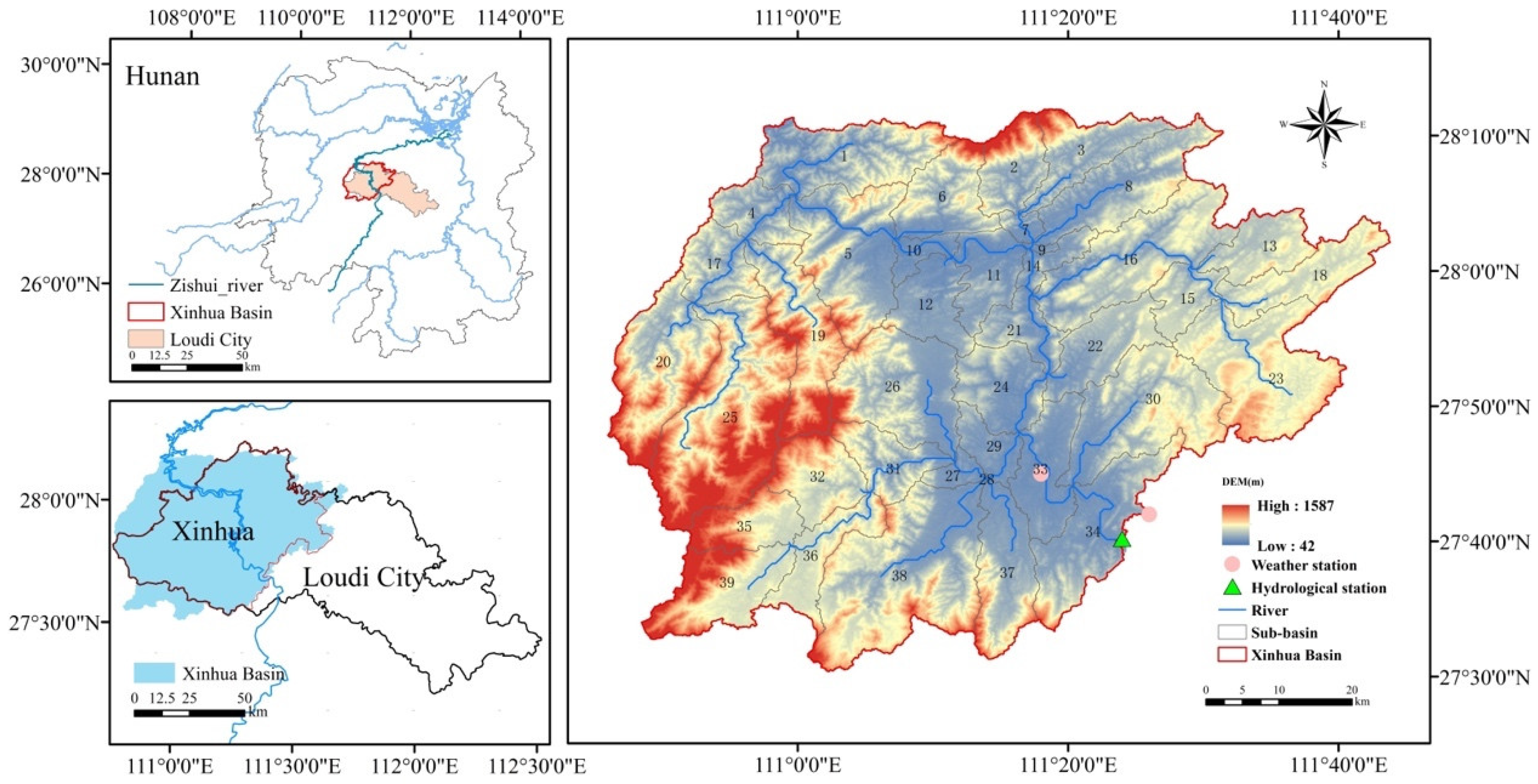
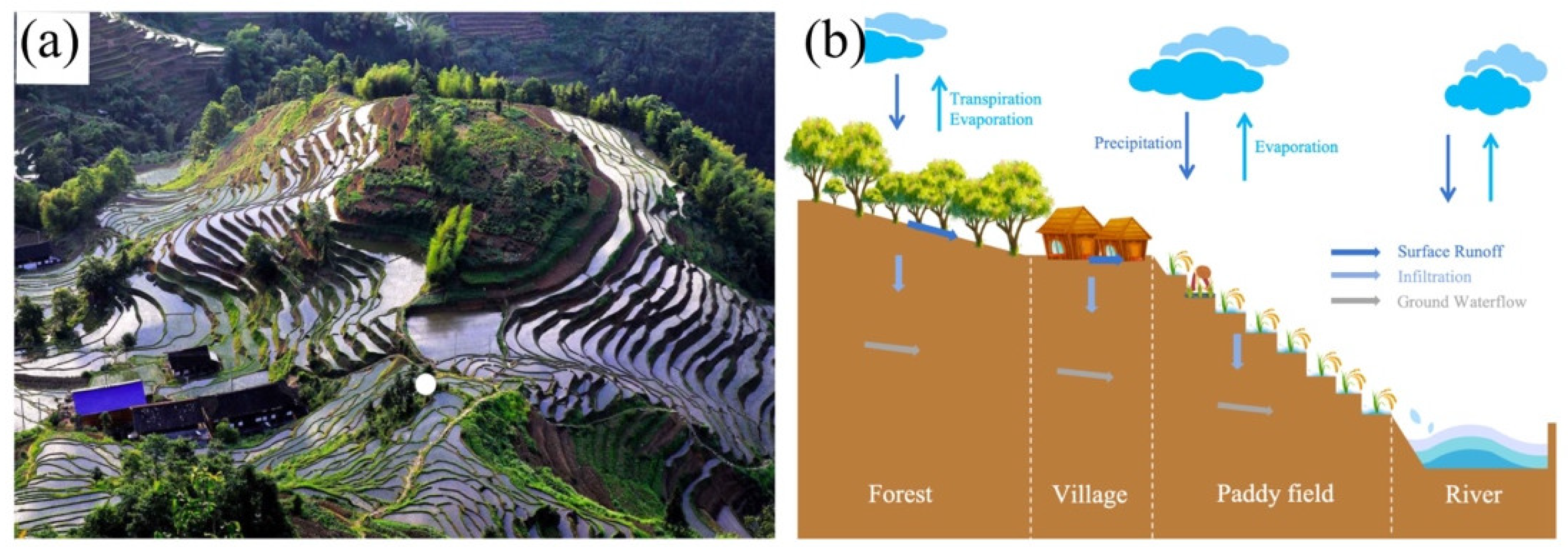


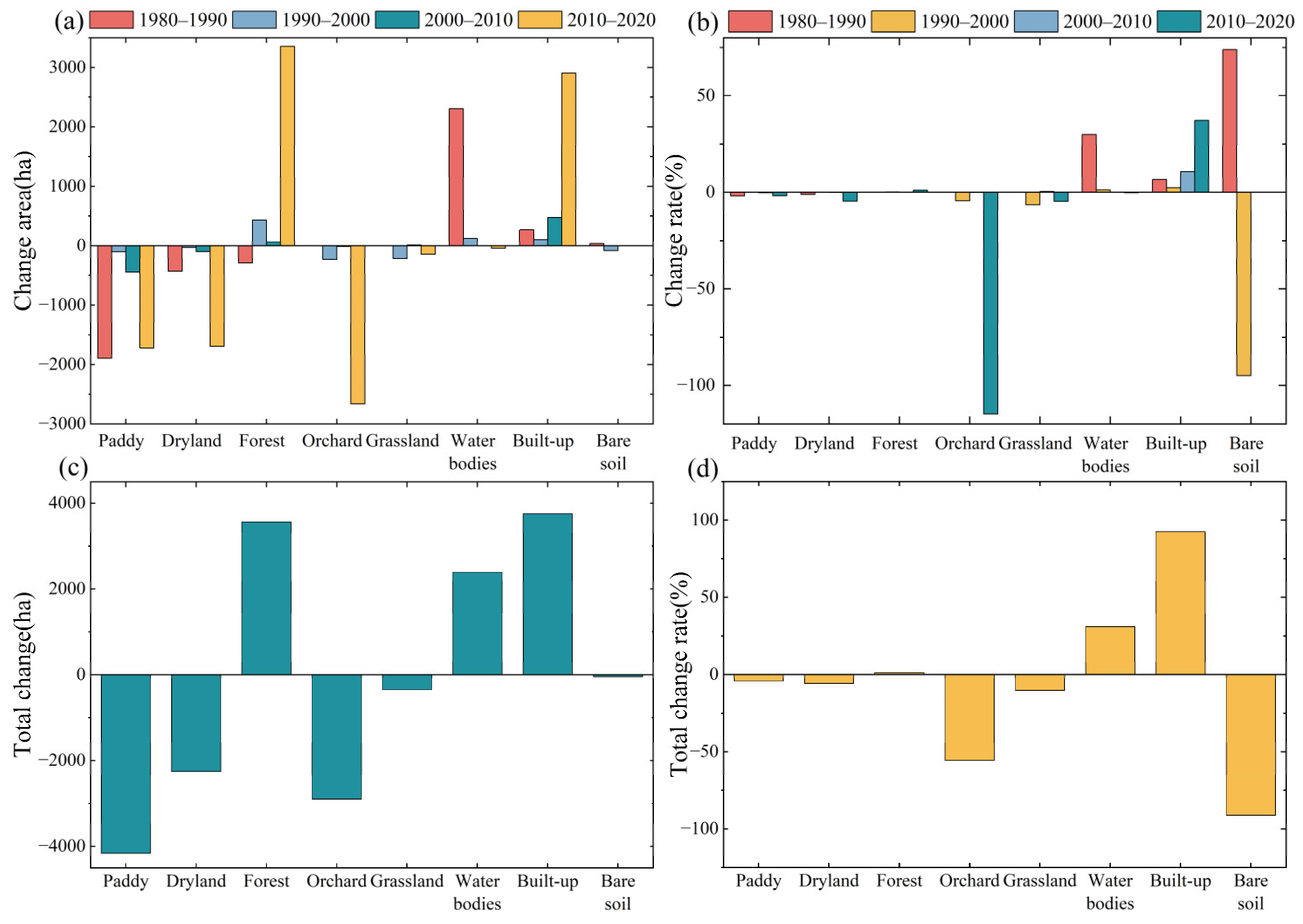
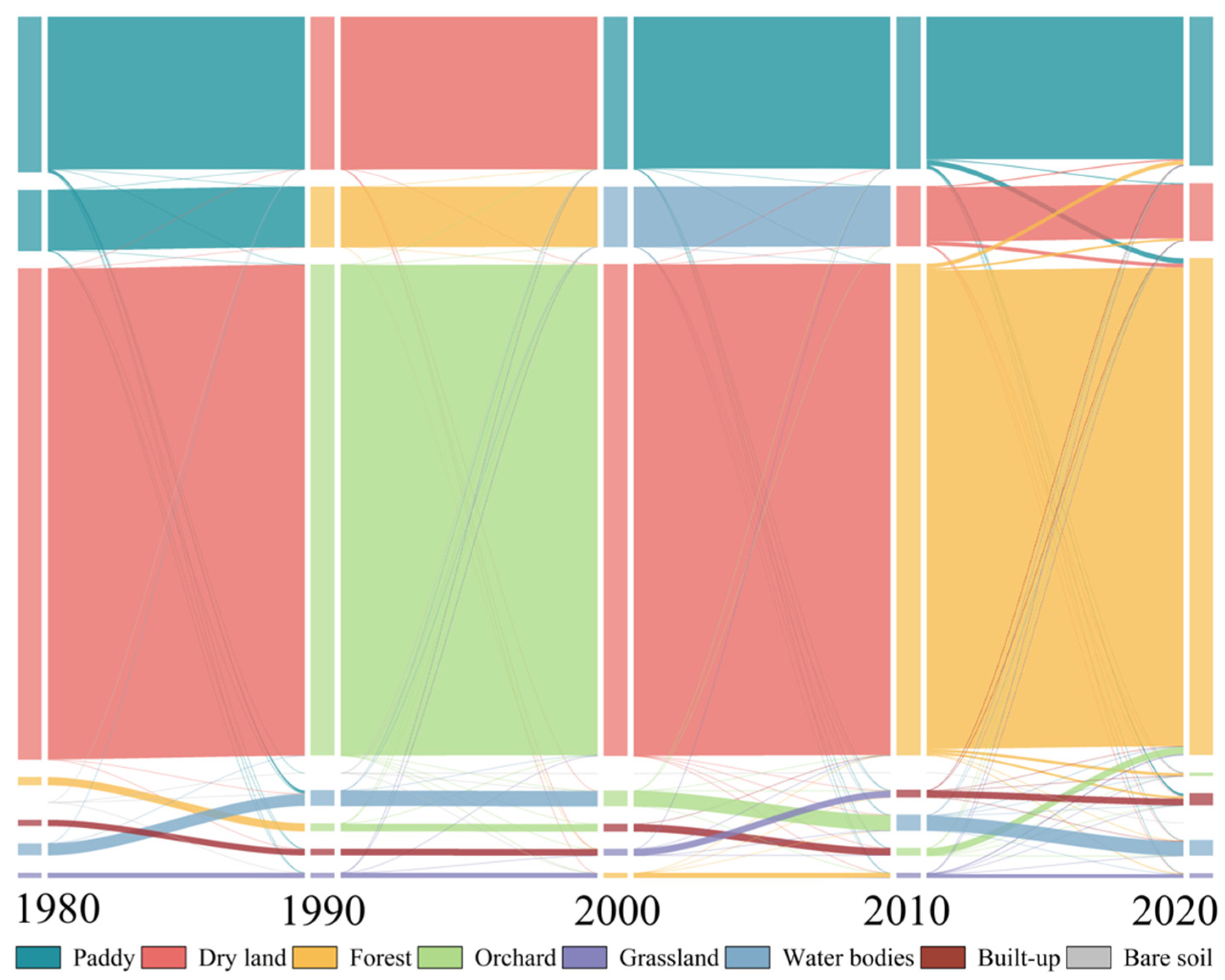
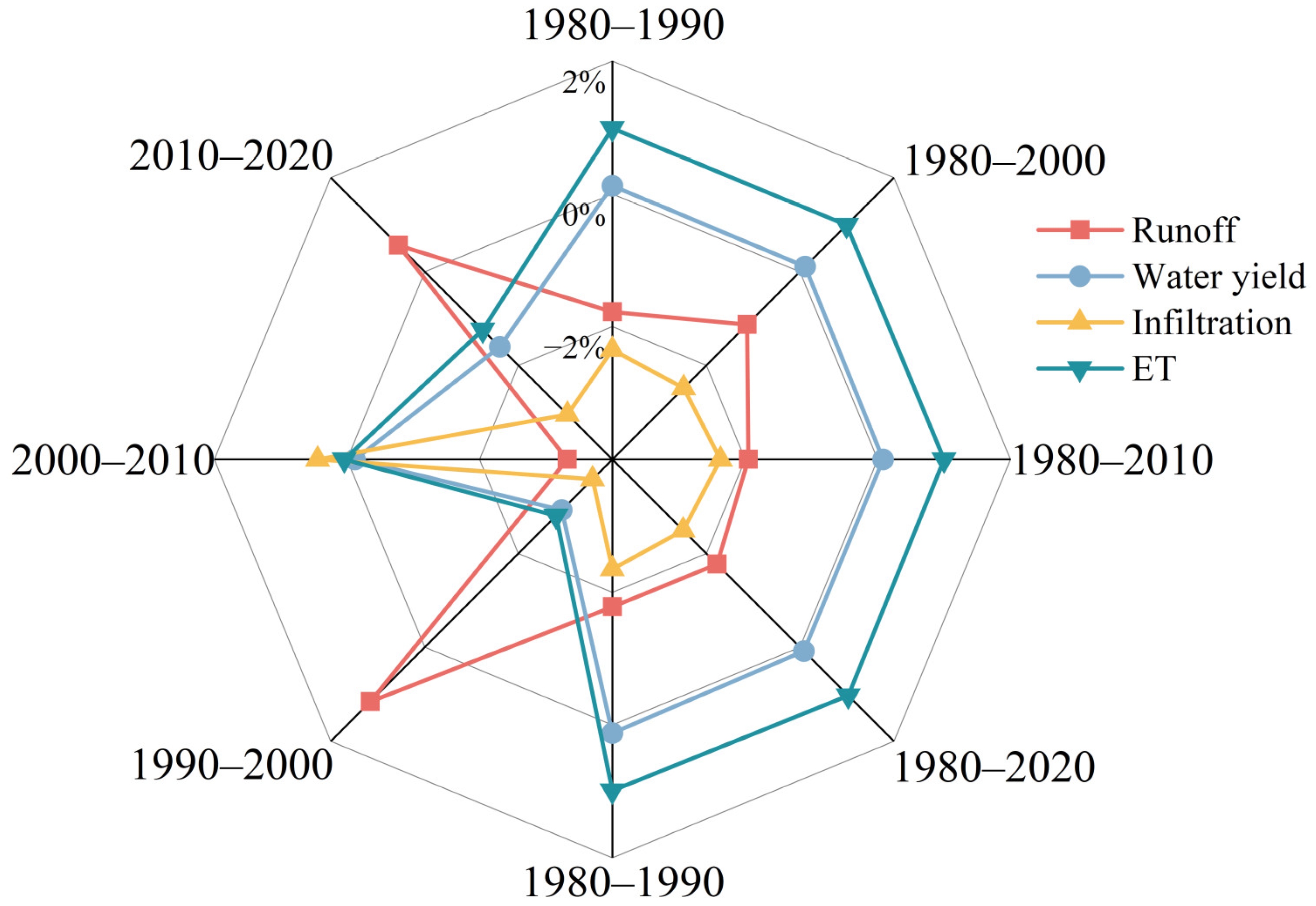


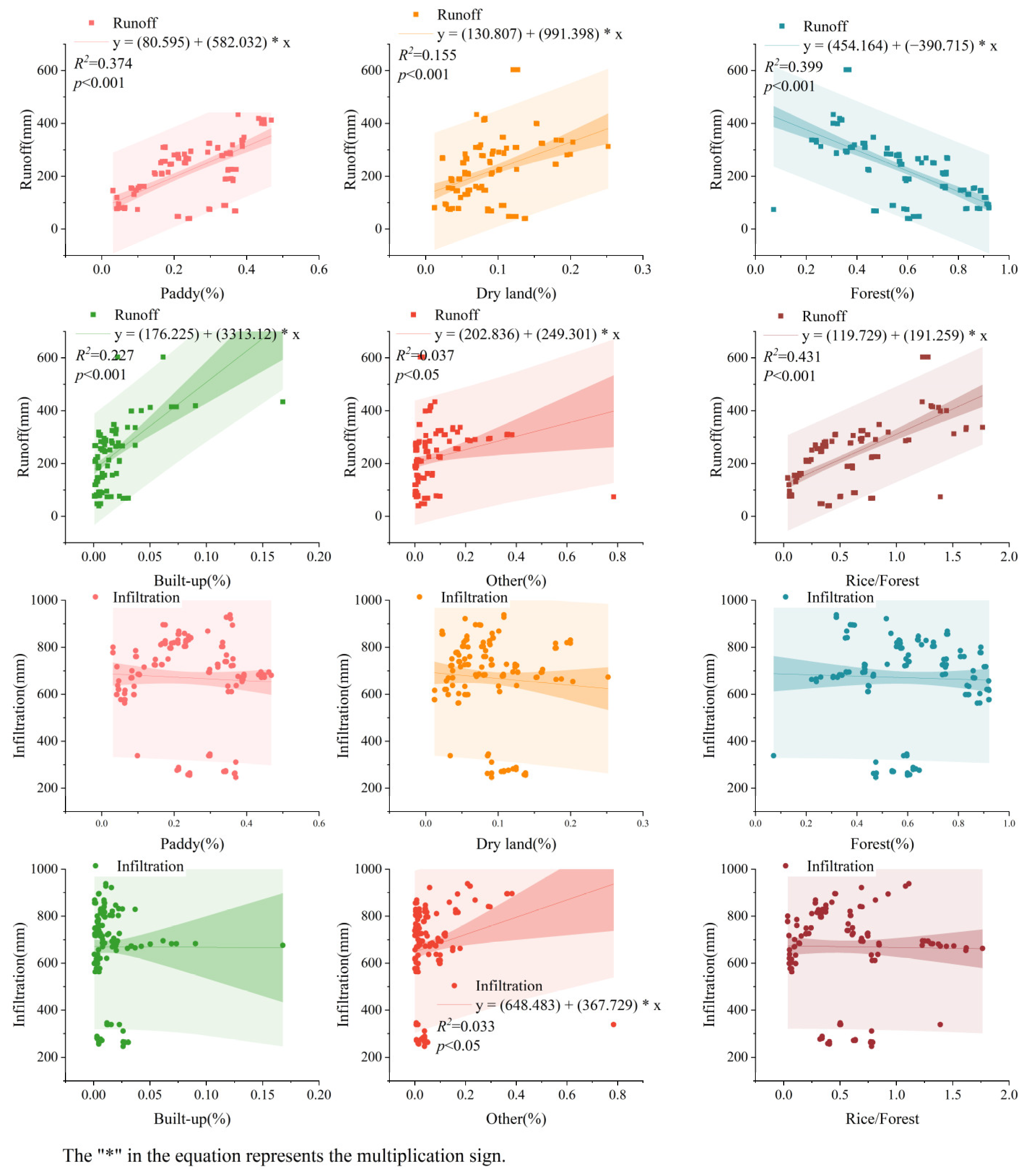
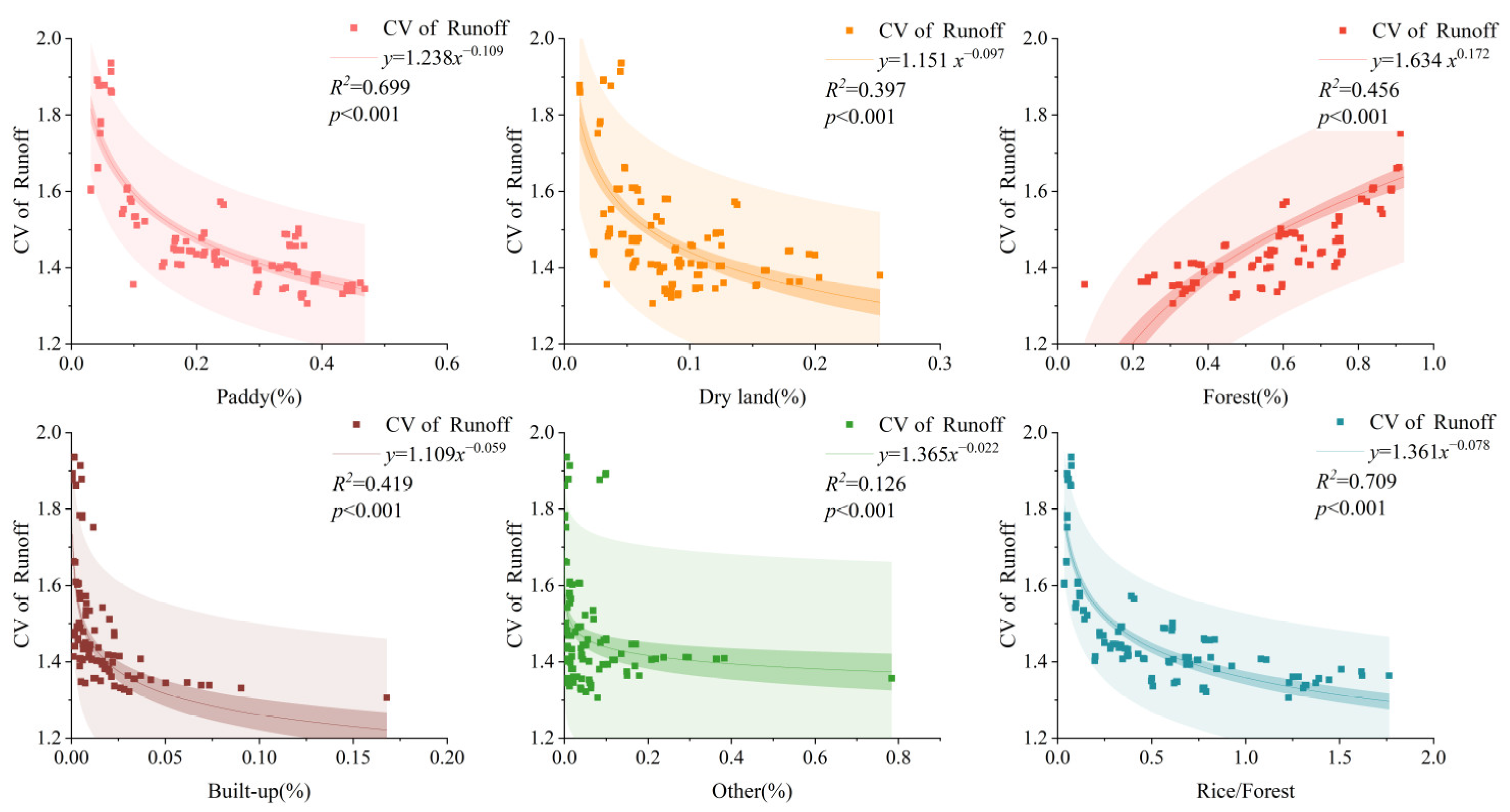
| (Proportion of Land Use) | Runoff (mm) | |
|---|---|---|
| Equation | R2 | |
| Paddy field | Runoff = 80.595 + 582.032 Paddy (%) | 0.374 ** |
| Dryland | Runoff = 130.87 + 991.398 Dryland (%) | 0.155 ** |
| Forest land | Runoff = 454.164 − 390.715 Forest (%) | 0.399 ** |
| Built-up area | Runoff = 176.225 + 3313.12 Built-up (%) | 0.227 ** |
| Other | Runoff = 202.836 + 249.301 Other (%) | 0.037 ** |
| Paddy/Forest | Runoff = 119.729 + 191.259 Paddy/Forest | 0.431 ** |
| Runoff = 286.621 + 199.059 Paddy(%) − 222.074 Forest (%) + 1499.529 Bulit-up (%) | 0.453 ** | |
Disclaimer/Publisher’s Note: The statements, opinions and data contained in all publications are solely those of the individual author(s) and contributor(s) and not of MDPI and/or the editor(s). MDPI and/or the editor(s) disclaim responsibility for any injury to people or property resulting from any ideas, methods, instructions or products referred to in the content. |
© 2024 by the authors. Licensee MDPI, Basel, Switzerland. This article is an open access article distributed under the terms and conditions of the Creative Commons Attribution (CC BY) license (https://creativecommons.org/licenses/by/4.0/).
Share and Cite
Deng, C.; Li, Y.; Liu, Y.; Liu, C.; Zhang, G. Rice Terraces Enhanced the Hydrological Stability of Small Watershed with LUCC—A Case Study of Xinhua Basin. Water 2024, 16, 712. https://doi.org/10.3390/w16050712
Deng C, Li Y, Liu Y, Liu C, Zhang G. Rice Terraces Enhanced the Hydrological Stability of Small Watershed with LUCC—A Case Study of Xinhua Basin. Water. 2024; 16(5):712. https://doi.org/10.3390/w16050712
Chicago/Turabian StyleDeng, Chuxiong, Yaqun Li, Yaojun Liu, Changchang Liu, and Guangjie Zhang. 2024. "Rice Terraces Enhanced the Hydrological Stability of Small Watershed with LUCC—A Case Study of Xinhua Basin" Water 16, no. 5: 712. https://doi.org/10.3390/w16050712
APA StyleDeng, C., Li, Y., Liu, Y., Liu, C., & Zhang, G. (2024). Rice Terraces Enhanced the Hydrological Stability of Small Watershed with LUCC—A Case Study of Xinhua Basin. Water, 16(5), 712. https://doi.org/10.3390/w16050712







